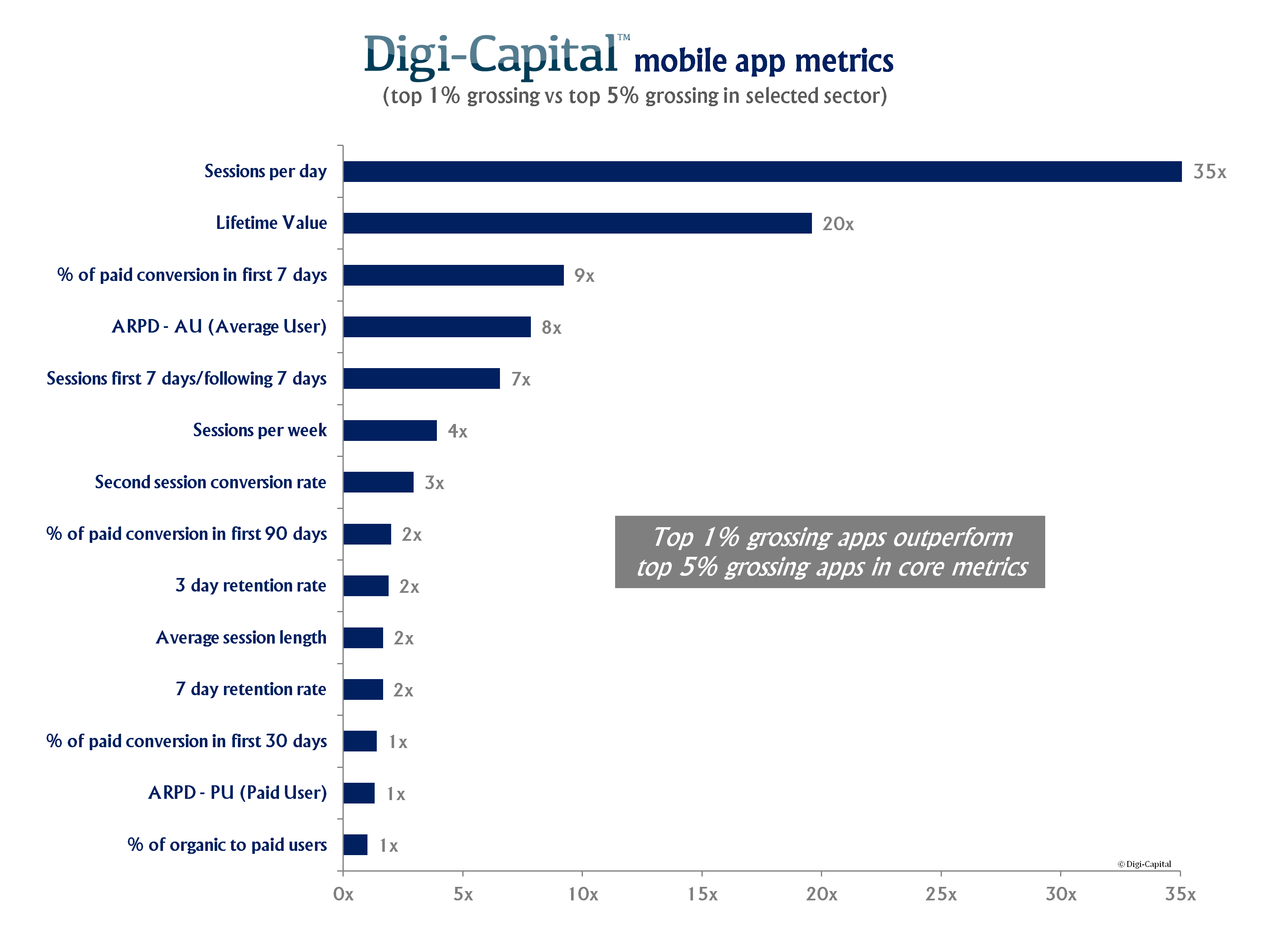Deconstructing King of Thieves
Let’s take a deep dive into ZeptoLab’s latest game King of Thieves. Launched in February 2015, this game has piqued my interest. While not on the top spot yet, the game’s bold design deserves a look.
In my opinion, this is a game that deserves to be successful. It feels unique and has all the elements that make up a top grossing game. ZeptoLab has taken what works in simulation and strategy games, and applies this to a totally new genre and a completely new target audience.
This approach is what I feel more new game designs should do to be successful on the AppStore.
The Pitch
The pitch for King of Thieves is “Super Meat Boy” combined with “Clash of Clans”.

The core gameplay is a one-button platformer. Your Thief (the little cute black shadow) automatically runs left or right. You can tap to trigger a jump in the current direction. You can also jump off walls to reverse the players direction. ZeptoLab has managed to give classic platformers a mobile makeover. With one-touch controls it feels native on mobile. With simple rules, it feels expressive and gives players plenty of options. The gameplay is simple and is very transparent about what you did wrong each time you die. This creates very addictive core gameplay.
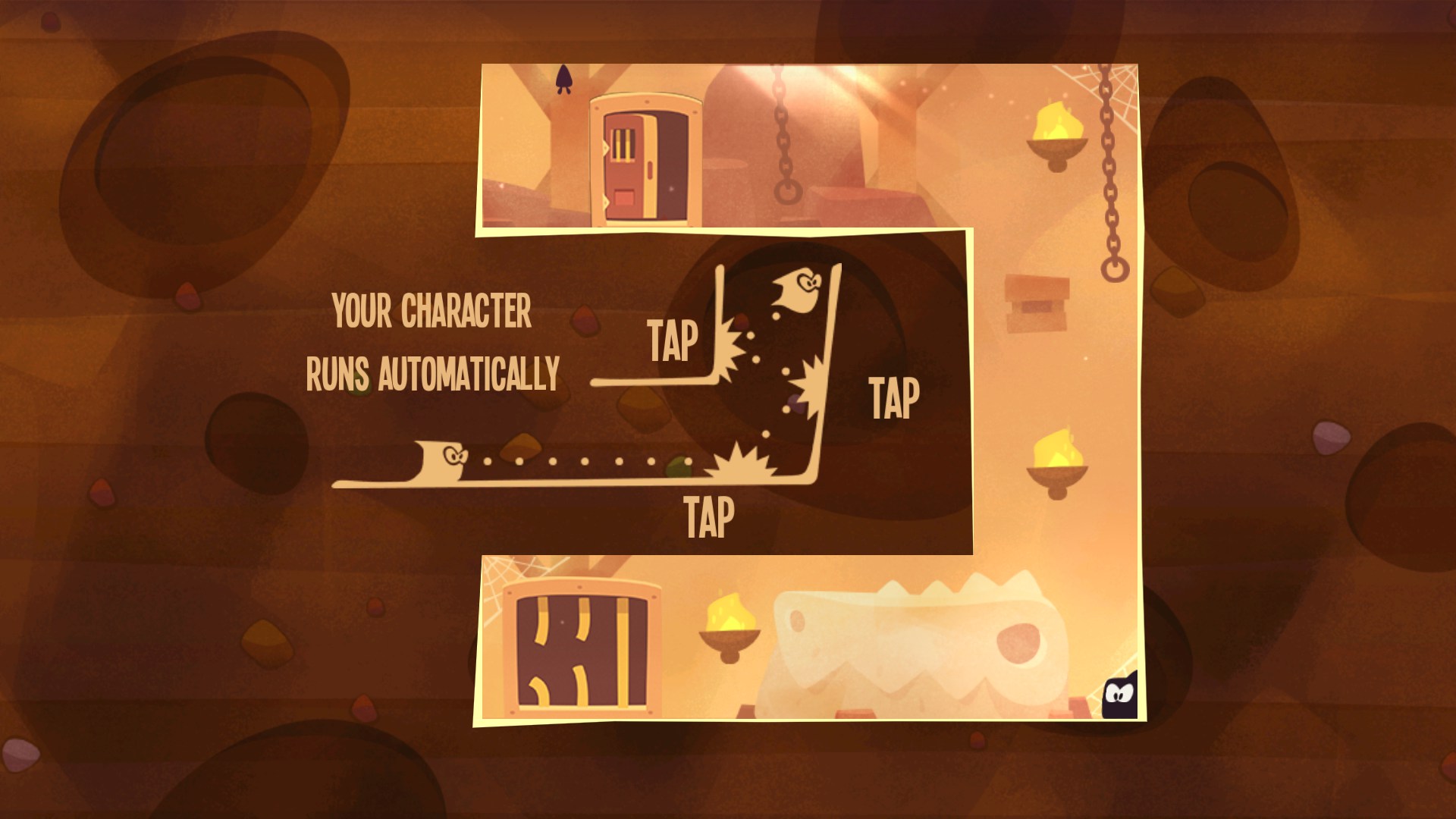
The object of each level is to reach a treasure chest. Go from “point a” to “point b” by avoiding traps. Hitting a trap will reset your progress right to the beginning. This punishment gives the game the “Super Meat Boy feel”. Reasons for losing are always clear to the player, and there is very little friction to restarting. The player jumps back into the action as soon as they are killed, making it extremely addictive to just keep trying to beat a level.
The meta (the progression systems outside of the core platformer gameplay) is a re-hash of Clash of Clans. They’ve managed to modify the standard Clash of Clans formula into something that works very well with the core platformer gameplay. Just like Clash of Clans, King of Thieves asks the players to manage two layers of gameplay: attacking and defence. On attack, the player plays platformer style levels to steal gold and gems (more on this later). On defense, the player must design a base that defends against other players’ attacks. Players sessions are focused on stealing as much loot from players around the world to upgrade their own abilities.
The Session Loop
To deconstruct, I’d like to focus on session design. To do this, we need to break down the game into its daily action loop: the repetitive actions the player takes to progress in the game. Let’s evaluate each step in regards to how it impacts the way the sessions feel.
Looking back at the post on Flexible Sessions, the key principle of designing sessions is about creating a diminishing curve of value for sessions per day and for session length. Just to reiterate: The first rule is that the first session of the day should feel more impactful than the 2nd, 3rd, or 4th time the player returns. By the 5th+ session, this should give minimal value to the player. The second rule is that session length should also have a diminishing curve of value. Eventually a player should naturally feel that returning at a later point in the day would be more beneficial. These two rules make up strong session design.
So how does King of Thieves execute this?
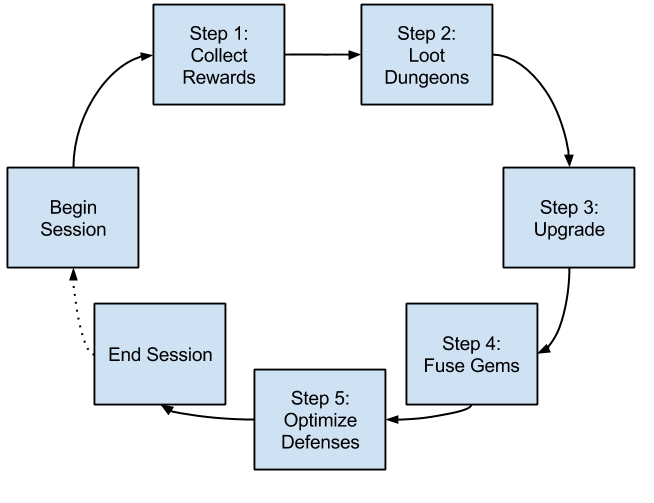
Step 1: Collect Base Rewards
Each day the player begins their session with collecting the rewards from their dungeon:
- Collect gold from their stash. (Optional Short Timer)
This is a bucket-filling mechanic. Allowing players to collect from the stash as many times as they wish throughout the day.
- Collect gold from successful defences. (Short Timer)
Making sure players feel good about their defences, players collect gold for every failed attempt by other players in their dungeon. While not a lot of gold, this certainly feels good when you’ve come back after a long absence
- Collect generated gems (Long Timer)
Gems generate on the map on a longer cycle (multiple hours).
You can see here that these three reward cycles each have varied timer length, which allows for strong session design. Short timers to value coming back more per day, but longer timers to reward daily play. Using rewards of varying length, the player has a clear diminishing value for returning multiple times throughout the day.
Step 2: Loot Dungeons with Keys
After the player has collected all their rewards, they want to maximize their cash for their current session. There is always the threat that other players in the world will steal any resources they have when they leave the game.
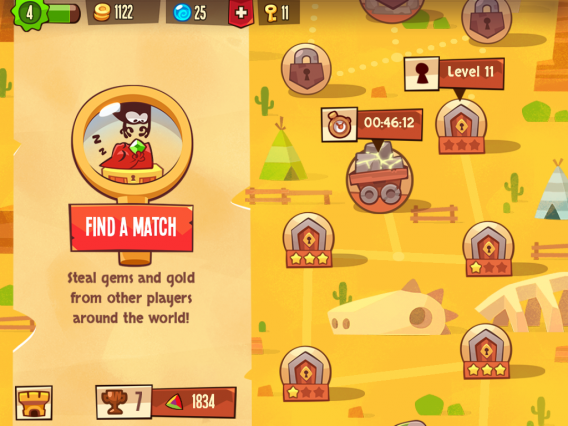
Players can choose between the PvP (left) or the PvE (right)
To do this, players loot other player’s dungeons (PvP levels) or designer-created levels in a map (PvE levels). Player-created levels hold high value gems. Whereas the PvE levels have higher gold rewards (sometimes), unlock new gem generating mines and new dungeons which the player can move to. This system works because both PvE and PvP benefit the player in different ways.
King of Thieves innovates with their pacing mechanics. Instead of using energy or lives like in most games, they use “Keys”. Keys refill like in most games with time. The key difference is that the amount of energy (or keys) the player needs to spend to enter a level is randomized.
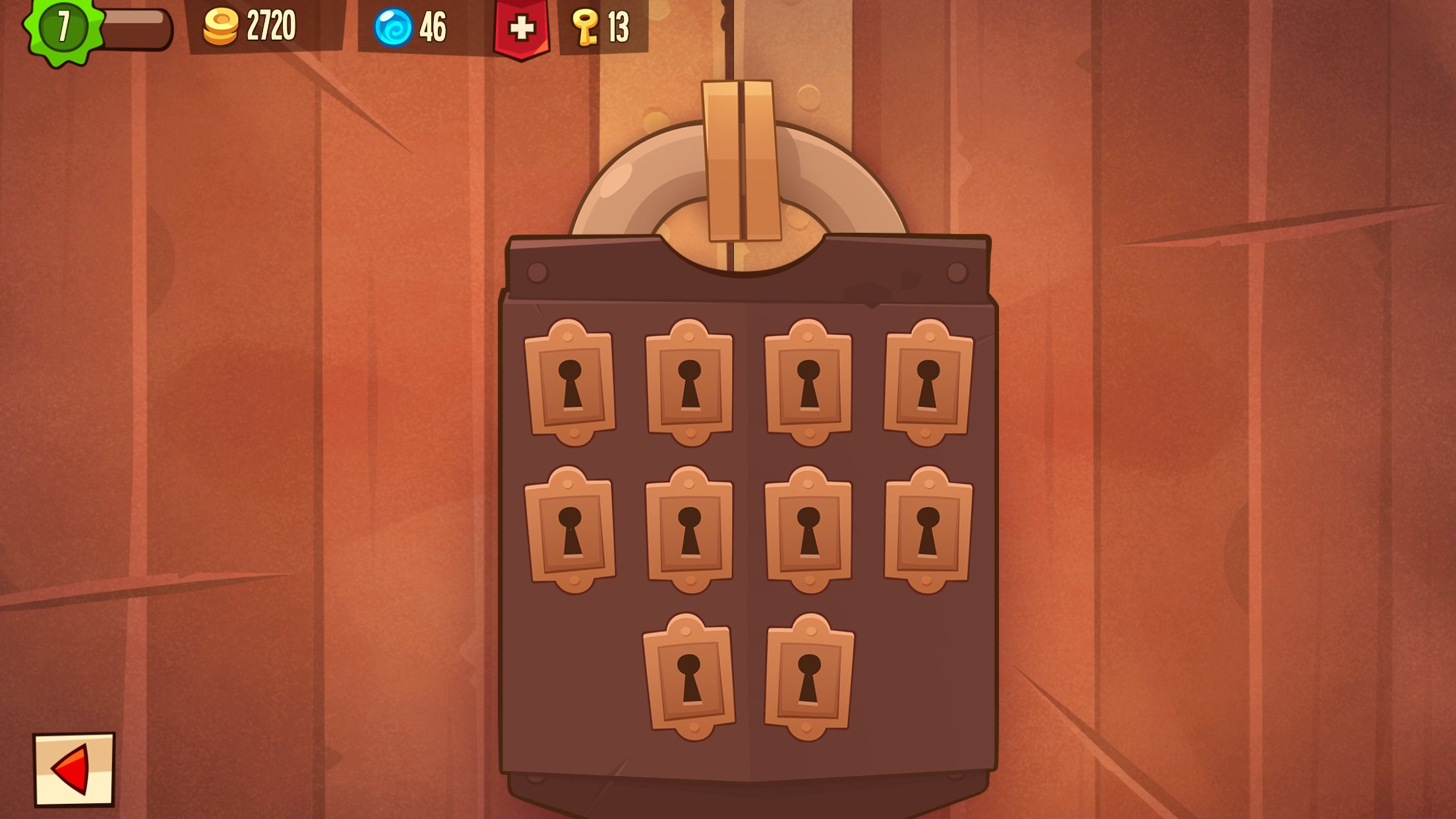
Players can choose a lock. Each attempt costs a key. Only one of them gains entry. Randomized Energy.
The player chooses locks on a screen with their keys. If they get the right key, they enter the level. If they choose the wrong one, they must spend another key. The game supplies the player with more than the usual amount of energy (10+). However, some levels can use 1 key to enter, others up to 15 keys to enter. Why would ZeptoLab design a system like this?
This system doesn’t please all player types. I’m convinced ZeptoLab benefits more from this system than the player experience. Not an easy choice I’m sure as a designer, but these sacrifices are sometimes necessary in a free to play game.
From the onset, this system feels arbitrary, just like an energy system. The player’s ability to loot is capped by some tacked on economy. Compared to Clash of Clans, Clash’s pacing mechanics make sense: you will eventually run out of troops to loot opponents. King of Thieves just says you run out of “keys”. Could this be fixed if the player had to “craft” keys in their base? Could this be fixed if the player had to build clones of their shadow player to start looting? Maybe. Overall I’m not a fan of the system, but I understand the benefits for ZeptoLab.
Because the system is randomized, players can try for one more level even if the player only has 1 or 2 more keys left. If they get lucky, this feels great. They get to play the level with little cost. If they fail, they are presented with this screen:
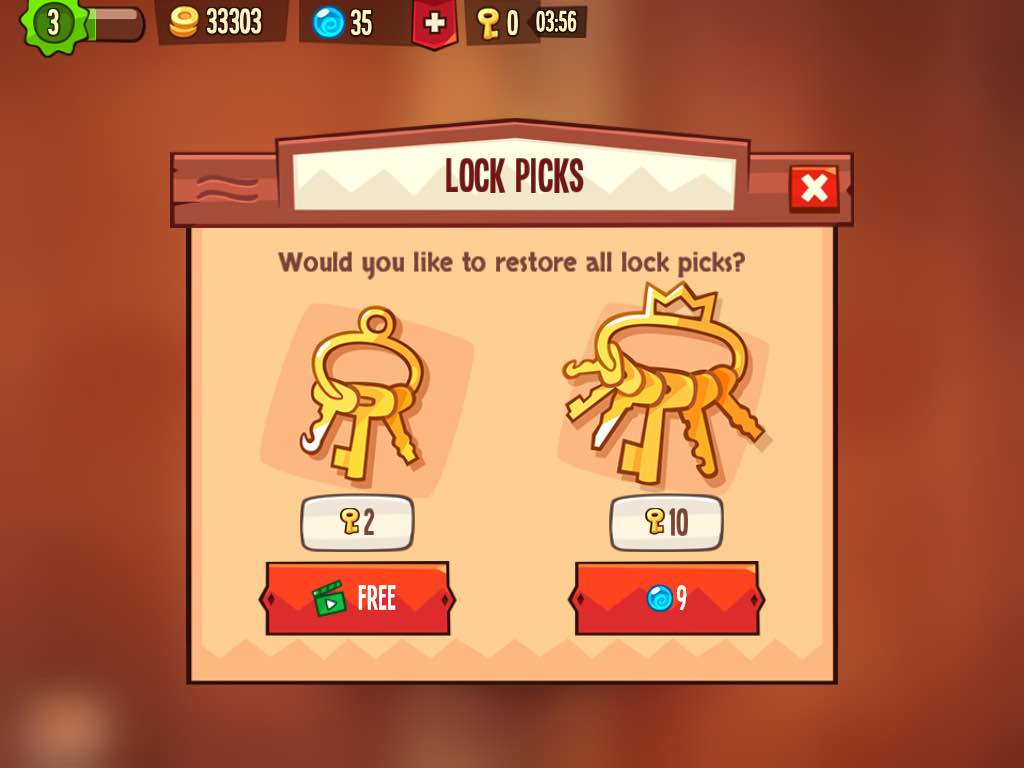
This screen is a high conversion screen for their video ads. Want to keep trying? Watch a video ad. Video ad revenue is becoming more and more interesting in the mobile free to play space, and I completely understand why ZeptoLab wanted to create a pinch point for this type of system. Players then binge watch some videos to get in that “just one more play” feeling.
On top of converting players with video ads, this type of randomized energy system also creates a nice way to balance harder and harder levels. Players can upgrade their key storage limit to be able to reach higher and higher levels. The higher the level, the more locks that the player must attempt. Also, this can create an interesting session per day value curve. ZeptoLab can use metrics like sessions per day and session length in their decision about how lucky the player is. This may be dubious, but this type of “invisible hand” to guide the session design can be very powerful.
In the end, I’m unsure if this system of randomized keys was the best choice for King of Thieves. The system is a unique design and I’m excited to see what the market thinks of it. Just based on the conversion to video ads, I think this could be something to try for other genres.
Step 3: Upgrade Your Base (or Else!)
After the player has looted as many dungeons as they could in that session, they may use their found coins to upgrade their dungeon and resource generation. Any coins left over will most likely be stolen, so players attempt to spend every coin they looted. This promotes going for one more looting session, or extending the session to purchase more gold.
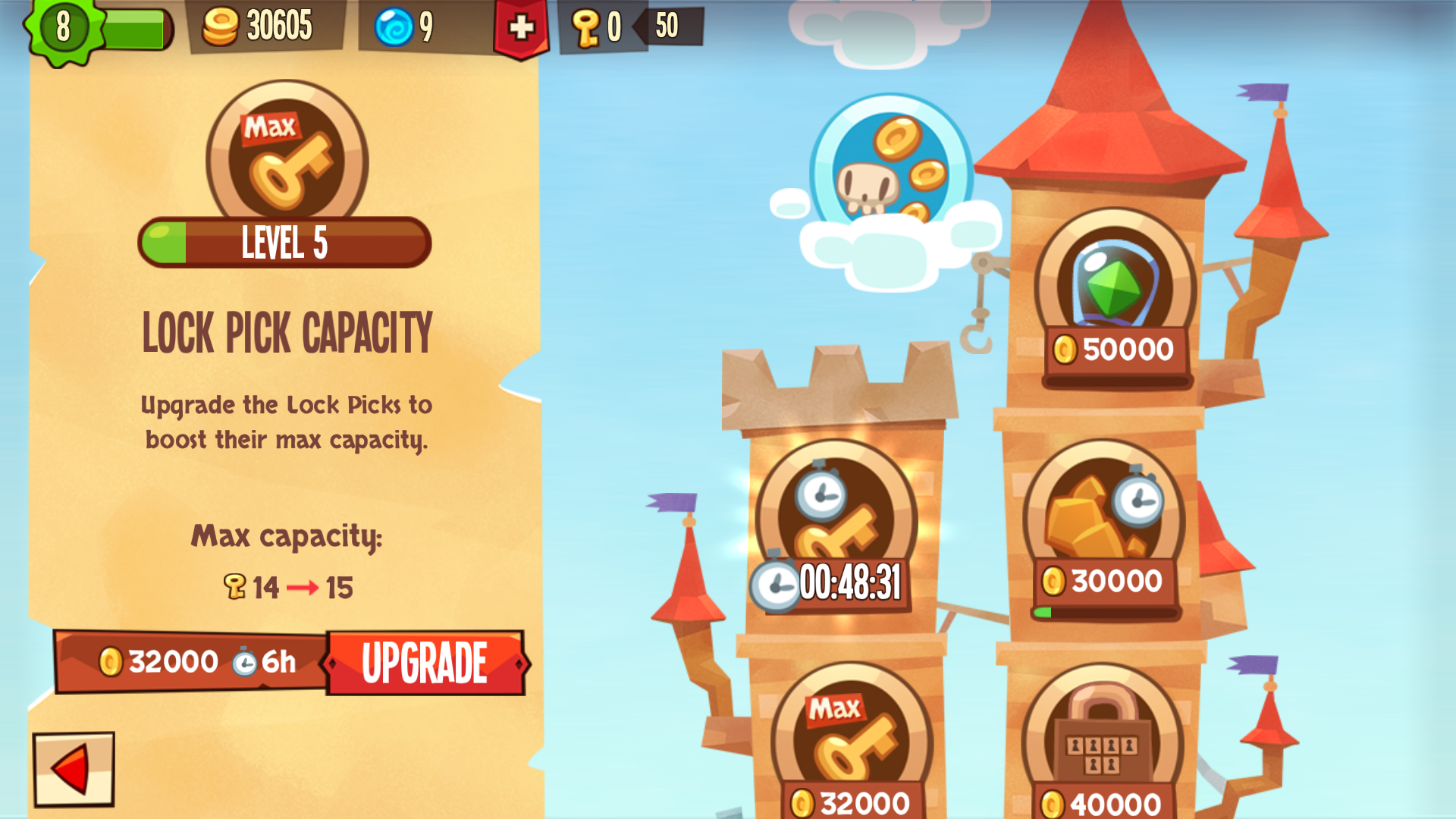
Step 4: Fuse Gems
The key to the meta and progression of the game is fusing of gems. Players collect gems from mines on the world map and by looting other players in the world. The player then takes the gems collected and fuses them in their base.
Fusing usually takes many hours (3+ hours for a usual gem). During this time the gems in this fusing ritual are open for stealing by other players. This is the most anxiety-inducing timer in the game. A gem will be stolen unless they keep the game open or have amazing defences. I spent about two hours on a weekend keeping the game open while watching movies because I was too afraid to close the app and lose my gems.
So why would players opt-in to this nerve wrecking timer?
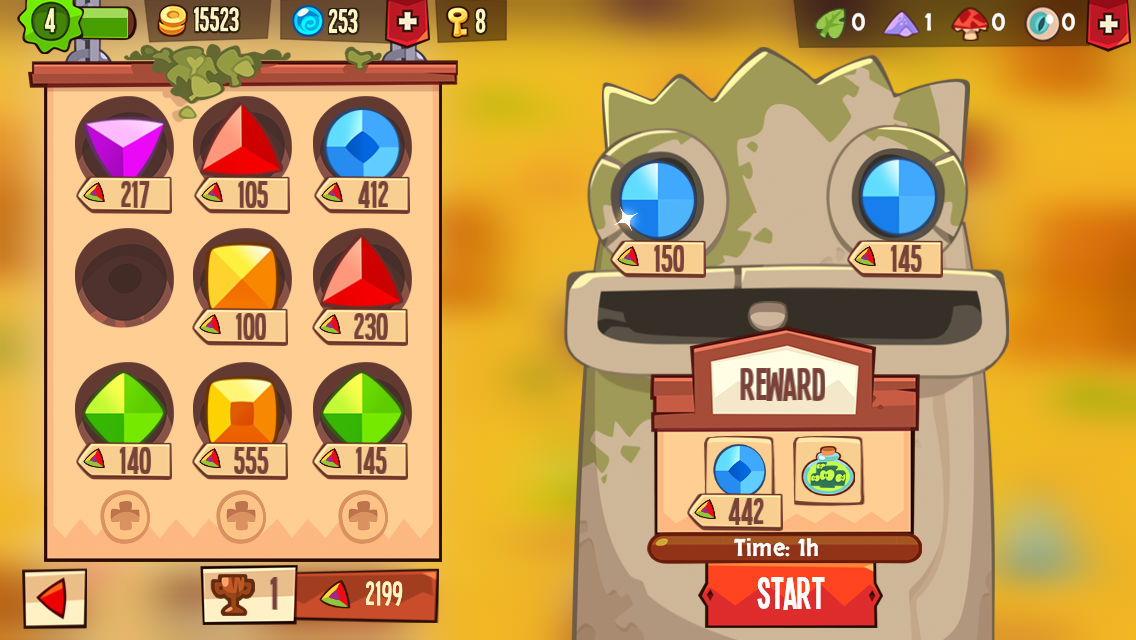
Increasing gem value is the goal of King of Thieves. The total value of your gems is how you rank in the game. Players are looking to retain only the highest quality gems (which is shown by a number). However, there are only limited slots the player can have to hold onto gems. So players quickly run out of slots and are forced to fuse gems together to make more slots for higher level gems.
This was a very, very smart design choice by ZeptoLab. This creates a natural cap for progression and creates a lot of very interesting choices for the player. It also creates an obvious high conversion item for monetization: the extra slots for gems. Similar to the builder in Clash of Clans, ZeptoLab has created a high conversion item out of these extra slots. I’m convinced that if they brought this to the forefront and made it cheaper for first time players, this could be a strong conversion item.
Step 5: Optimize Defences
After they’ve completed this loop: collect, attack, upgrade, fuse… what’s left?
Just like in Clash of Clans, players can extend their sessions by optimizing their dungeons defence layout and adjust the positions of traps. This comes with one caveat: the player must be able to beat their own level twice… in a row.
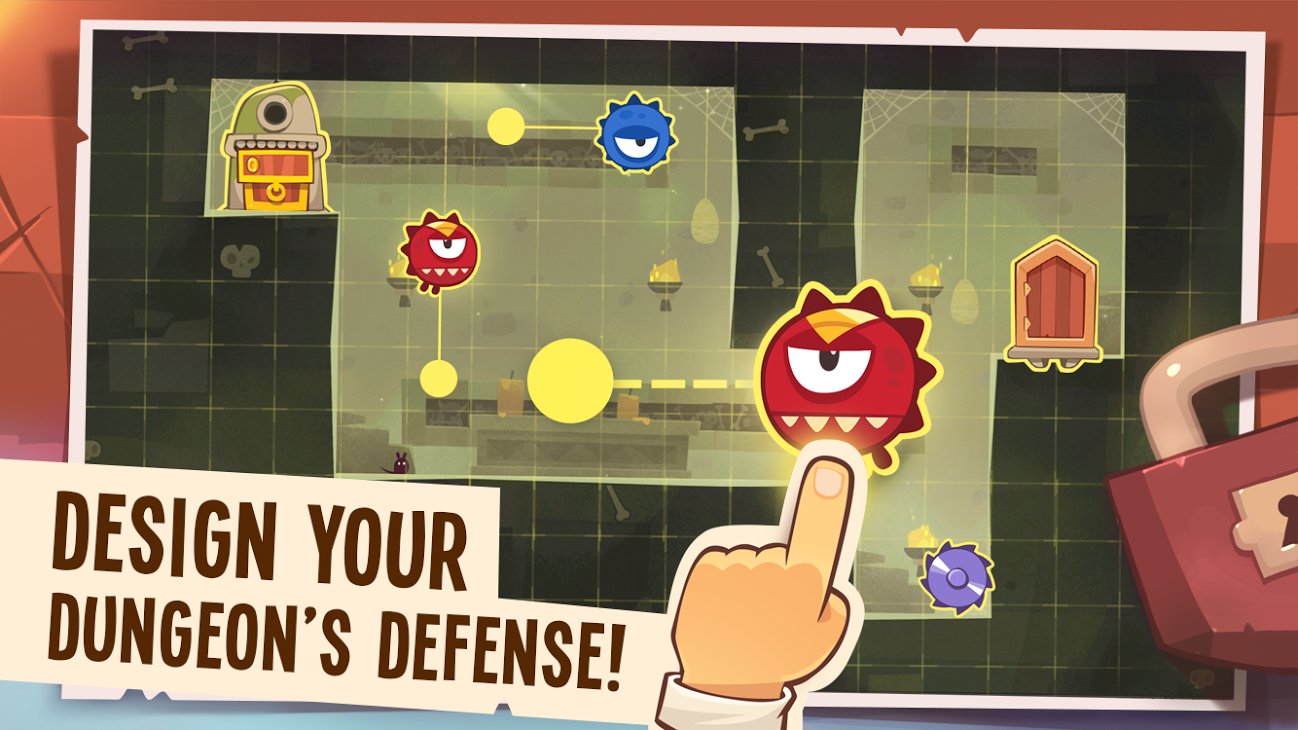
This definitely creates a session extension. I’ve spent well over a half an hour trying to create the optimal dungeon design. All this time was not incentivized by the game, but I wanted the best layout possible. This is exactly what you want to create in your session design. A session extender that players can take as little or as much time with as they wish. The value diminishes over time.
What King of Thieves did right: Social Pressure Mechanics
ZeptoLab shows an excellent example of how to add effective social mechanics to a game. Asking players for help to retrieve lost gems creates social pressure. I feel good about helping my friends, I enjoy when my friends help me out when I’m less active. I rely on my friends to help me optimize my fusing timers. The value of having active friends is apparent.

The league system creates a nice PvP environment with a clear reason to collect gems. Instead of feeling like I’m levelling up just based on some arbitrary number the designer has created for me (ex. collect 5000 gem value in 5 days), I’m competing against a living breathing opponent. I have to be engaged to compete, and the number is always growing so I never feel safe about my position. Sometimes I wish there were ways to specifically steal from other players on the leaderboard you were competing in. This would really drive up the competition.
King of Thieves also uses the same idea of clans in Clash of Clans. King of Thieves wants you to join a Guild. While the system is clearly in its infancy, it shows a commitment by ZeptoLab to the future of the game. Guilds are what will really drive the long term retention, and including it in the global launch was important. The mechanics at this point are still too early, but in the coming months I expect that ZeptoLab will build from this base and make very competitive play between Guilds stealing gems from each other. I hope they find a way that Guild members can work together on a dungeon or a raid. It would also be interesting to incentivize Guilds to put their most valuable gems in a vulnerable position. This will really drive competitive gameplay between the Guilds and give a collective goal.
What King of Thieves could improve: Hardcore Skill
In the translation of the Clash of Clans metagame to Super Meat Boy style mechanics, something fundamental was lost. Because platformer gameplay is inherently so skill-based, the translation still feels like a massive amount of skill is required to win.
Clash of Clans (as discussed before) although it requires some mix of stats and skill, the main determinate to win each fight is Stats. If you have an amazing army, you are going to win. If you have spent a ton of time (or money), you will be able to dominate against an opponent lower than you. As you defeat more of these easier players, you will be matched higher and higher in the leaderboards. This will demand more skill, but mostly more stats. This system allows players to “hover” around matchmade opponents that challenge their skill level, but still require high stats. Even if I’m terrible at selecting where my troops go, I’m still progressing, and I may be lower on the leaderboard compared to other players at my stat-level, but I still am progressing.
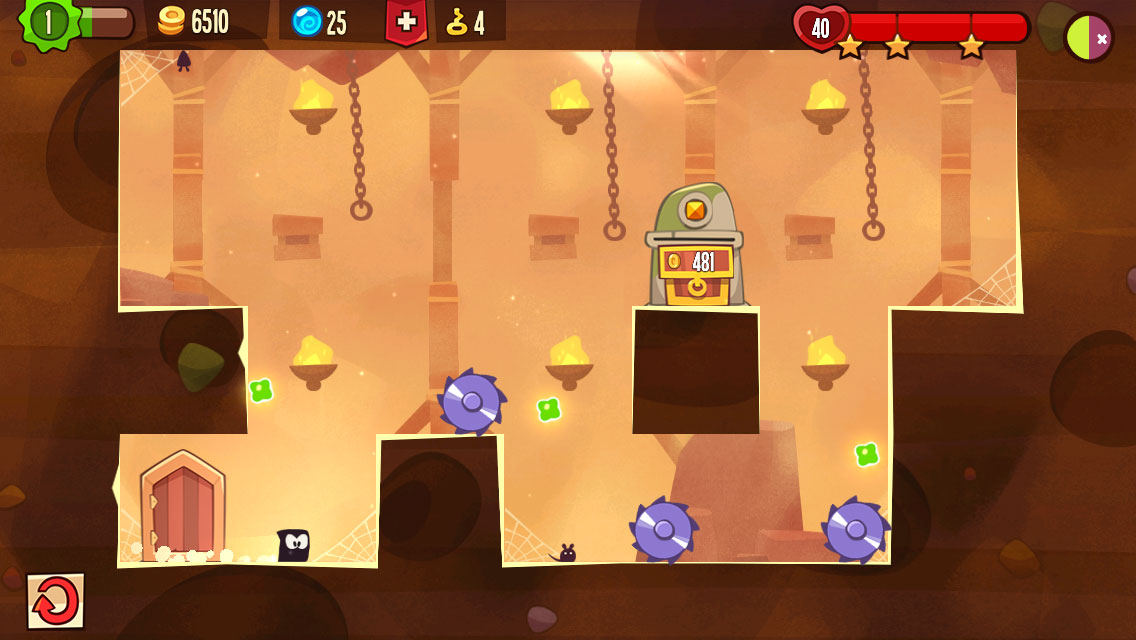
King of Thieves is never flexible over the amount of skill it requires from players. As you progress in the game, it keeps demanding more and more skill from its player base. As a result, the game feels very hardcore. The players that reach the end game are a smaller and smaller niche of highly skilled players. Why does this happen?
As the game progresses, players slowly get harder and harder obstacles they can place in their dungeon. In order to set up a dungeon that is difficult, the player has to beat it themselves. As a result of this system, unless a player is highly skilled, their dungeon, regardless of the defences, will remain at the same low level of skill-difficulty. There is no way for a player to increase their defence without actually being far better at the platforming game.
There are some stats that affect the game: the damage of the obstacles, your shadow’s equipment and armour, the amount of keys you have, etc. But these stats clearly take less of a precedence over the skill. In my opinion, there are some levels that you just need high skill. So as you progress in the game, no matter how much time or money you’ve put into the game, you will reach levels that it doesn’t have an impact if you don’t have the skill. There is no “hovering” in the matchmaking that allows players to feel progress regardless of skill. Players with low skill will feel it: they are punished by losing levels very often.
This is most likely an artifact of trying to combine a high-skill genre (Super Meat Boy) with Clash of Clans. While this pushes away players that are expecting a lower skill level, I think it also engages the highly skilled players even more. The tradeoff between a highly engaged niche target audience and a flexible broad audience appeal is incredibly difficult to get right.
The Results:
On launch, the app was featured by Apple. This drove hundreds of thousands of downloads, but has yet to crack the Top 100 US Grossing. Can it get there? This will be an extremely tough. After a featuring, the only way to drive the necessary volume to reach the Top Grossing Chart is to purchase installs. This is extremely costly.
However, the game supports very strong early day retention and with more work can improve their long term retention. With continual improvements, this game has a chance to reach a stable position in the Top 250 Grossing.
Personally, I’m cheering for ZeptoLab. This design is refreshing. I had the feeling that the mobile free to play space is even more risk-averse than the console/pc space. This feels like a step in the right direction. This is a game ZeptoLab should be proud to have worked on. I hope other game developers can look at this example on how to innovate in new genres
Mobile Free to Play: Games that don’t want you to play them
More and more games now are adding modes where players no longer even need to play.
Players can simply open up the app, start a round, flip a switch, then put their phone down. The AI will make all their decisions. The AI will have all the fun while the player waits for the virtual reward at the end of the round.
At first glance, this is worrying. This turns the game into a Skinner box. Tap the button, wait, get a reward. Where is the fun in that?
Instead of making the core battle so boring that auto-mode is necessary, shouldn’t designers seek to add more depth to the battle?
No.
Focusing design on in-depth core game mechanics is a losing battle.
Focusing on making long-term decisions more interesting is a much better strategy for free to play games.
Battles are the Hook
In the RPG Genre, having an interesting battle mechanic provides the hook for the game. This is what draws players in and immerses them in the world. If I have no option of control, then this isn’t really a game.
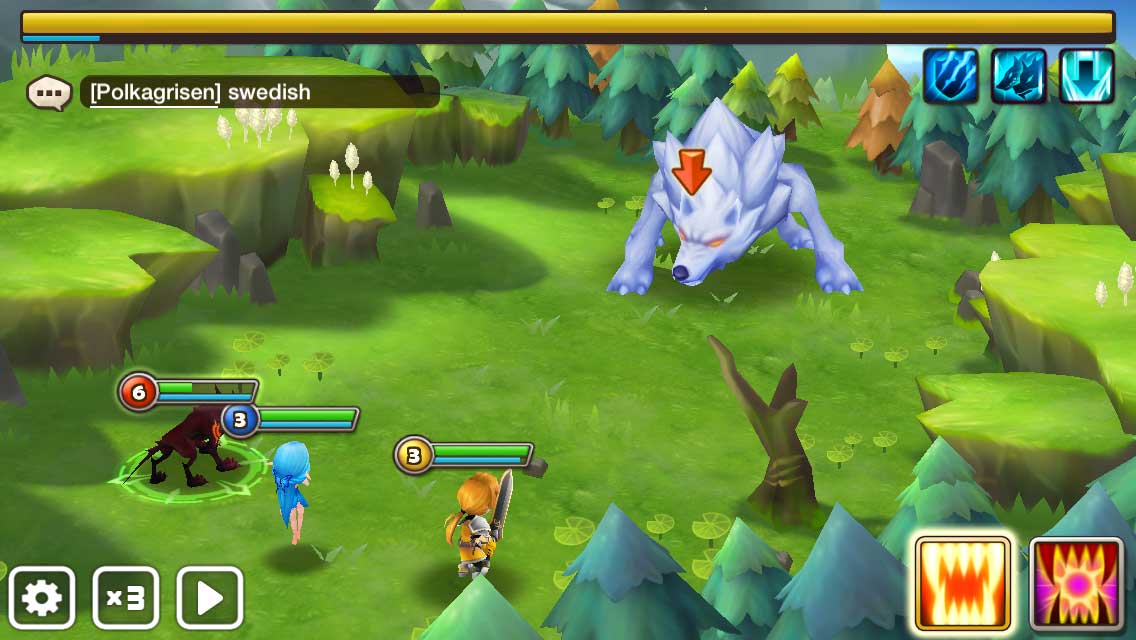
When a player starts a battle, they expect to make choices and see their impact. Having novel mechanics in the battle provides early players with a new experience that they have never had before. As seen above, in Summoner’s War, in the beginning, you have choices for each of your players of where they need to attack. This is engaging at first, but quickly goes stale. This isn’t the focus of the game.
Secondly, it really showcases the artwork. Your artwork sets the expectations right from the beginning. A player is only willing to invest in games that feel polished, exciting and professional. Making sure that players experience as much exciting battles in the beginning is important.
However, as they play many battles, inevitably the mechanic will get boring. Inevitably the artwork will get repetitive. There are few games in the history of game design that have ever managed to keep a core game mechanic interesting thousands of times repeatedly (ex. Tetris, Chess, Collectable Card Games). Especially in a non-multiplayer context, in a casual game, and even more in a mobile context where the interaction complexity possible is limited. In theory this could be done, but it would be incredibly difficult.
So how do you keep the gameplay interesting for the long haul while still allowing for a great initial experience?
Bitcoin Billionaire
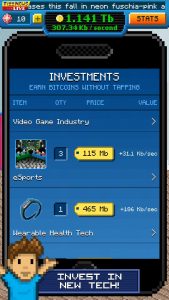
Bitcoin Billionaire is in a weird genre. I’m not really sure how to label it… It’s part simulation, but mostly an “Endless Progression” style game. Your goal is to try to collect as many Bitcoins as possible by tapping the screen.
Initially there is the appeal of just madly tapping on the screen. Each tap gets you 1 Bitcoin. You strum your fingers across your ipad watching your money go up. You’re so good at this!
But after about 30 seconds this starts to become a bore (also your fingers are getting tired!). So now the game starts to push you into making investments: earn Bitcoins while you’re not tapping.
What this does is ease the player away from a newly-boring core mechanic into something much more interesting: managing investments and optimizing the rate of progression. Bitcoin Billionaire has done an excellent bait and switch: you came for the tapping, but now you are addicted to buying income sources. Cookie Clicker, Make it Rain, Clicker Heroes and Bitcoin Billionaire are four excellent examples of games that have managed to ease a player from a boring core mechanic into something that is much more interesting in the long haul.
This transition is exactly what all games need to deliver for successful long term retention. So how do we add this to other genres?
Auto-battle is how its been added to the RPG genre. Eventually the game recognizes that making choices in the battle is no longer interesting. The bait and switch becomes making the choices outside the battle more interesting than the battle itself.
But Auto-Battle isn’t a trivial system to add. Like all design decisions it comes with benefits and consequences.
There are 2 questions to ask if an Auto-battle system will work with your game:
Session Design: Auto-Battle or Job system?
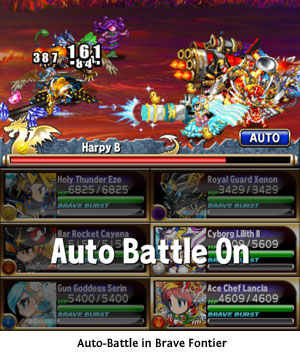
Auto-Battle as a system essentially means that a player will make a choice about which “dungeon” to enter, then leave their phone on and come back to it after a few minutes.
Is this valuable to your session design? Players just opening your app for long periods of time? It will effect your KPIs — your session length will go up. But is that really what you want in the design? Successful games push players to return to the game often throughout the day and focus on meaningful choices. So why demand that they keep the app open during the battle?
Job Systems in games have been around for quite awhile. They reached a peak with games like MafiaWars in the early days of Facebook. A player would send their units on Jobs. Tap a button, and the unit would be disabled for a limited time. When the time was up, the rewards for the action were given. This was a nice appointment mechanic that allowed players to opt-in to coming back to the game. If the game was only job systems however, the game grew stale. But what if a Job System replaced the need for auto-battle?
What may be more interesting is asking the player to make a choice: Do I send my fighters out without my control for 5 minutes, then return with the loot? Or do I think the AI will mess up this battle, so I should do it manually for the next 10 minutes? This way players can make a choice whether to end their session and come back later, or improve their chances of winning by playing the actual battles manually.
Is there enough depth outside of the battle?
If the game is really distilled down to a few taps each day this can get boring quickly.
Grinding for rewards and items is only fun when there is significant complexity and depth to collecting items.
By adding auto-battle in the game, this will put much more stress on your long-term meta mechanics. Do your players have enough interesting decisions outside the battle that will last for months?
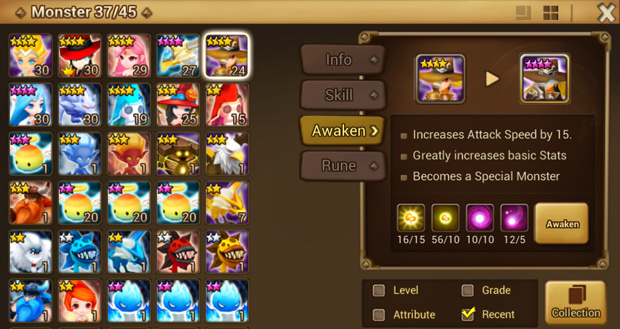
Summoner’s War has Relics to provide interesting decisions in how you upgrade your players. Brave Frontier has the boosting and fusing mechanic which provides years of collection and interesting long-term trade-offs. Many games have a very in-depth loot system which makes for interesting decisions choosing which gear to keep.
However, even with a strong loot system with collection, players need an indicator of progress. They need to be immersed in your setting, story and game. Having an auto-mode is great, as long as eventually players will be pushed to an epic boss battle. A battle that surprises them, challenges them, and maybe even progresses the story. This will be necessary wrapper around the grinding that makes it all worth it. These auto-battles end up building anticipation to something new and exciting for the player.
In the end auto-battle lets players focus on the choices and decisions that matter to them, no matter what stage of the game they are in.
Mobile Session Design: Flexible Sessions
Mobile Session Design defines a game’s ability to pace its content and create strong long term retention. It’s one of the biggest indicators for a game’s long term success. I’ve spoken about a number of considerations you need to have when designing sessions:
Firstly, you need to ensure your initial user flow into the game allows players “Easy In”. They quickly understand what they need to do, and how to accomplish it.
Secondly, sessions need an “Easy Out”. Players need to slowly and subtly be prodded to leave the game to ensure they don’t burn through your content or burn out in interest too quickly.
Thirdly, you need to ensure during a player’s session they are making commitments to come back. Driving strong re-engagement and creating habits to return.
Lastly, I spoke about allowing players to return to the game naturally in search of surprising content or offers. Ensuring your game has cycling content throughout the day to pull players back like the masters of session design: Facebook and Twitter.
With these components you can build strong sessions that will last for months, even years.
To bring it all together, now it is about making these components feel natural and unrestrictive to the player.
The Problem with Energy
When it comes to session design in free to play, the natural tendency is to add an energy mechanic. Energy is a cheap and simple way to pace players. They come into the game, have full energy and can only spend a specific amount of it before its time for the player to leave. Later on in the day, they receive a push notification telling them that their energy has refilled, they can play again! When completely depleted, energy can be purchased to play a few extra sessions, although energy is no longer is really an effective monetization mechanic.
Energy has always been a tacked on mechanic in many games. It’s an aging industry standard that players are pushing back against. Players now demand that games don’t feel nearly as restrictive towards when and how they play.
So what is the real issue with Energy?
Issue #1: Energy gives an abrupt end of the session with no commitment
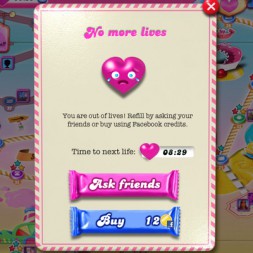
Energy was necessary to create the “Easy Out”: giving a players a reason to leave, and giving a strong reason to come back. However, this is not a player commitment — this is just them running out of a pacing currency and now having to wait for it to return. Players don’t make a an opt-in commitment to return to the game when their energy runs out, instead they just feel they are being prevented from playing for no reason. Energy thus has a strong stigma, and I’ve seen large drops in user funnels when players realise their sessions are being controlled by such an arbitrary economy.
Issue #2: Energy has communication issues
Energy sometimes just doesn’t make sense in a game’s theme. It costing energy to do every action feels weird. In previous social gaming environments this was the standard, but in today’s mature mobile market energy being tacked on doesn’t translate well.
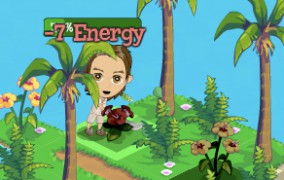
Lives are taking some precedence in match 3 games or skill based mobile games. This makes some sense and translates well. If you fail, you lose a life. It’s been a staple of the Arcade. It has meaning and players feel like they have an impact on how long their sessions will last.

I am convinced Lives remained a staple in even modern Nintendo’s design because it created this “Easy Out”. Giving a players a reason to walk away from a game when they were getting too frustrated by it. This made sure they would return another day to try again.
Issue #3: Energy doesn’t pace engaged players
Energy works because it allows for many play sessions per day. With short refill timers for lives, player can keep coming back throughout the day with full lives and try again. However, since simulation games push players into much longer timers for benefits, simulation can pace their content a lot better. In the long run, a city building system is much better at pacing its content than an energy structure.
Pacing content with energy is difficult because highly engaged players can come back 20 times per day and have full benefit. The optimal would be that their benefit for returning would slowly taper off instead of grow in a linear way. So a hyper engaged player wouldn’t blow ahead in the content compared to an average player.
What ends up happening in a game like Candy Crush is that you have to balance your games to ensure that regardless of engagement level, a player gets new content in a controlled, steady flow. But with energy and allowing players to come back with full benefit throughout the day, designers can end up pacing content for way too long for the average player. Conversely, they could just not care about these hyper engaged players ripping through their content and allow them to progress quickly. Yet these are your super fans — these are the players that would gladly pay you if given the opportunity!
What Flexible Session Design looks like
The optimal Session design will seek to pace Benefit vs Sessions per Day and Session Length in this manner :

A graph which the growth rate slows over time. The benefit for playing 10 sessions per day is higher than 1, but it grows at a much slower rate. Also for session length: Playing for 2 minutes has great benefit. Playing for 6 minutes has more, but grows at a slower rate. This is optimal for keeping players growth controlled, while still encouraging strong re-engagement.
Boom Beach’s Sessions
Boom Beach have one of the best mobile sessions around.
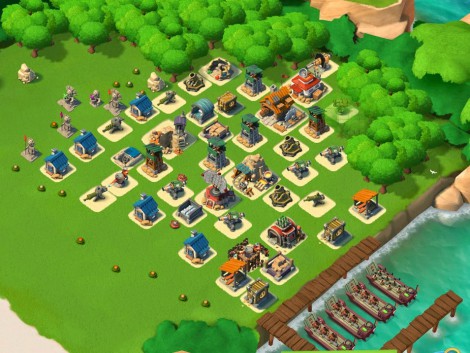
Boom Beach follows the rule that the first session of the day is the strongest: your longer timers (buildings) have completed and you collect a majority of your resources.
Some players can come back a second time that day and get a similar benefit. Yet as the game grows these timers get longer which makes the second session less beneficial.
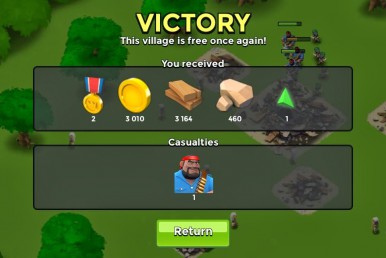
The benefit of coming back beyond this is mostly just to battle. This is the funnest part of the game. This can give some big currency rewards and random rare drops. However, the more you raid other player’s bases, the more likely it is that you will be raided. This makes the benefit taper off as the day continues.
Clash of Clans even has a mechanic if you are active in the game, no one can attack you. This strongly recommends re-engagement for players that are paranoid about their resources, but because the game is still paced, they aren’t progressing fast when they come back for these “defensive” sessions.
So this works for Clash of Clans and Boom Beach, but how do I apply it to other genres? Especially other genres that don’t have a town building or simulation component?
Idea #1: The longer you play, the harder it gets
Smash Cops Wanted Level is a good example of a flexible energy mechanic. Each time the player plays a round, their wanted level increases (similar to GTA). This means each subsequent time they play the game will get more and more difficult. 1) This makes complete sense given the nature of the game. 2) It allows the illusion of allowing the player to play forever :

http://toucharcade.com/2013/10/17/smash-bandits-update-removes-play-stopping-timer-and-adds-other-cool-goodies/
Idea #2: Separate playing and progressing
Hearthstone does this beautifully where they really allow players to come and play as much as they want, but the currency is only tied to completed missions. Missions regenerate the next day.
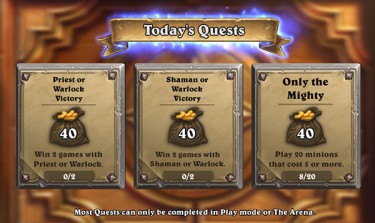
Of course this only works if you are confident core mechanic can last this long. This is a feat only very few designs have pulled off. I’ve only really seen it in Trading Card Games and MOBAs (ex. DOTA or League of Legends). If you believe even the most engaged players won’t bore of your core after playing it constantly for months, then you can consider opening it up without restriction. Especially if you’re going after a more core or traditional gamer audience which is outspokenly negative towards obvious timers or energy mechanics.
Idea #3: Take a bet on your skill
A combination of lives and a randomly generated level list is a good way for players to manage their own sessions and prevent session burnout.
As I spoke about before, a game can allow for a list of missions to be randomly generated. Each has a different tradeoff between risk and reward given the player’s current level in the game. This list is regenerated on a quick timer, so players can always come back to the game to search for “deals” on which level to pick on this list. Which level do I think I can beat, that will give me the best reward?
They make the call whether they go for broke on a difficult level or go for grinding missions with significantly less reward. You can subtly control the drop rate of these types of levels to ensure that players aren’t going to get too many grinding levels and exploiting the session design this way.
With the life mechanic, players are adequately punished for losing a level. Adding urgency and making this a really interesting decision. Plus, with the “Shopping for levels” mechanic, the player has reason to come back throughout the day but is still restricted from always getting what they need.
Keeping your sessions flexible will make the game feel much less restrictive. This in turn will really make players feel that your game is something that will adapt to when and how they want to play. This attitude will turn into strong play sessions per day and much stronger longer term retention.
Mobile Session Design: Deal Hunting
Continuing from my last post, I’d like to dive deeper into driving re-engagement on mobile.
Driving long term retention continues to be the focus for mobile free to play developers. As marketing costs for launching titles continues to hit new highs, it becomes more and more important to retain players over the long haul.
The first strategy for driving players to come back for a long time is about designing your game’s features so that players are committed to returning. Players activate timers to trigger a notification in a few hours. Players could also push another friend to play a round, then receive a notification when its their turn to play again. These evoke a very “explicit” session design. There are push notifications always notifying you when you need to come back to the game. Very obvious reasons to return to the game.
But this is exhausting and can lead to very structured session designs that don’t bend around a players life. It also gets really tiring, very fast. Players getting notifications in the middle of the night, feeling like in order to play optimally they need to return.

South Park described this behaviour perfectly in the recent episode mocking free to play games. Waking up in the middle of the night to tend crops gets old really fast.
As a result, explicit push notifications are fine for triggering 1-3 sessions per day. However, any more than this and the game just turns into an annoying Tamagotchi and players will break away from your game.
But 1-3 sessions per day frankly isn’t enough for free to play games. Looking into some industry data from Digi-Capital, we can see the importance of Sessions per day and its correlation with hitting the top grossing :
Hitting a strong session per day count is a very good indicator for a top grossing game. So how do we design a game that pulls the player back very often?
Learn from the Masters: Facebook & Twitter
Facebook and Twitter are the clear winners on mobile for sessions per day.
But Why? What is driving us back?
There are direct messages and notifications — people post about us or message us. This provides the “explicit” notifications. Players return because they are committed socially to reply to these messages and look at their notifications.
But why do we open up facebook every time we’re in line at the grocery story? Even when there are no notifications on the phone? Why do we pick up twitter every time we have a boring break in a conversation?
Because of the news feed. Because there is always something to check, always a hope that something new is going on.

Why do you open up Twitter every 15 minutes? Because there’s always something new on the feed. There’s always an anticipation that you could find out something new if you just checked in quickly…
Throughout the day the content on both of these networks is changing rapidly. A user can come back once a day, five times a day or a hundred times a day and still get enjoyment. This is what mobile free to play needs to strive for.
Going Deal Hunting
Alright, so game design can’t provide the same amount of new content and surprises that a social network can. But that doesn’t mean that we can’t hit the same level.
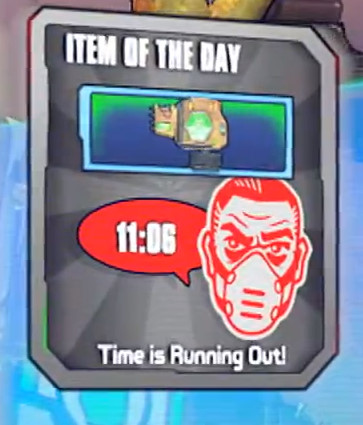
I came back to the shops often in borderlands to see what the deal was.
A first great example of creating this session design feeling is cycling content in shops.
For shops, you don’t have all the items available at all times. Some of the best moments using the store in Borderlands or Diablo was when the store had the exact item that I wanted on sale or for a deal. If your design supports a huge possible library of items to sell, then a cycling shop is a must. Highly engaged players feel great finding deals on items that were previously too high. Players always have hope coming into the game that there might be the solution to their problems available in the shop for a deal. In short: the shop provides a feeling of something new and interesting that could change their fortunes. If the cycle is short enough, and the deals good enough, this can really push players to come back throughout the day. It also adds urgency to purchasing behaviour — each deal feels like a once in a lifetime opportunity.
Of course we’ve seen this behaviour in other forms as well. Ebay, Craigslist, and Steam Sales are great inspiration for creating a store that really pushes players to come back constantly to go deal shopping.
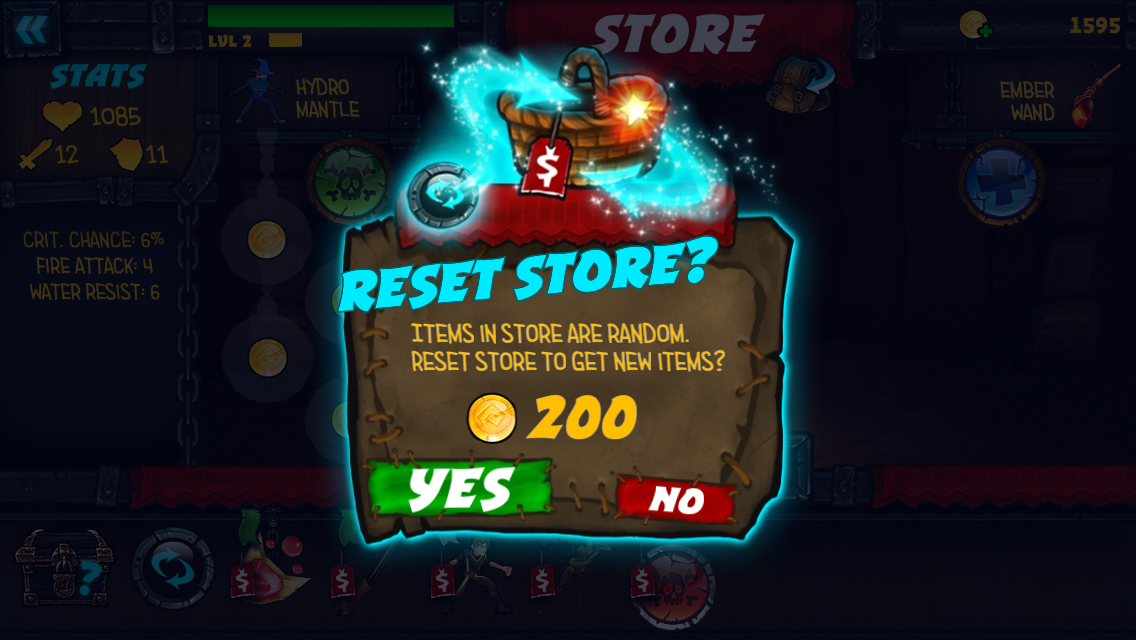
Also, this cycling can create some other interesting monetization mechanics. You don’t want to come back throughout the day? You really want to find that item quickly? Then pay some currency to refresh the store. You can see this in the recent Backflip game, “SpellFall”.
Shopping for Level Design
Of course this constant cycling isn’t limited to just in-game shops. This same mentality can be applied to your progression system or matchmaking system.
Let’s take for example a game like Boom Beach. What would happen if you only have 10 opponents you could play per hour. Every hour, the full list is refreshed. Players then would shop the deals on this board. This hour, which of these opponents are the easiest to beat and provide the best reward? Then each hour they return and search for the “deals” on this board which will help them progress. This could be a great replacement for the current system where players feel like they are matched with extremely difficult opponents and can only progress by grinding the PvE computer levels, greatly reducing the importance of PvP in the game.
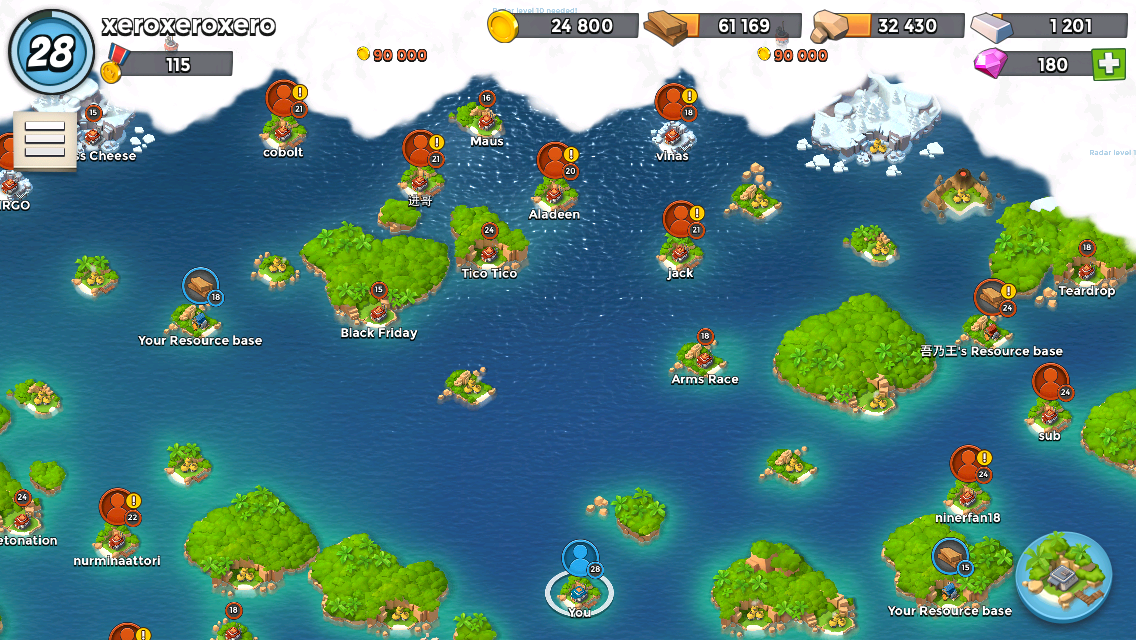
Everyone on the map is too difficult to face. There never are any deals here.
Having levels that cycle and change throughout the day is a way to add interesting choices a PvE or level based game. Puzzle and Dragons have Event dungeons for very limited time. Making these more central to the daily grind and progression is a great way to add more interesting choices and pull the player back more often.
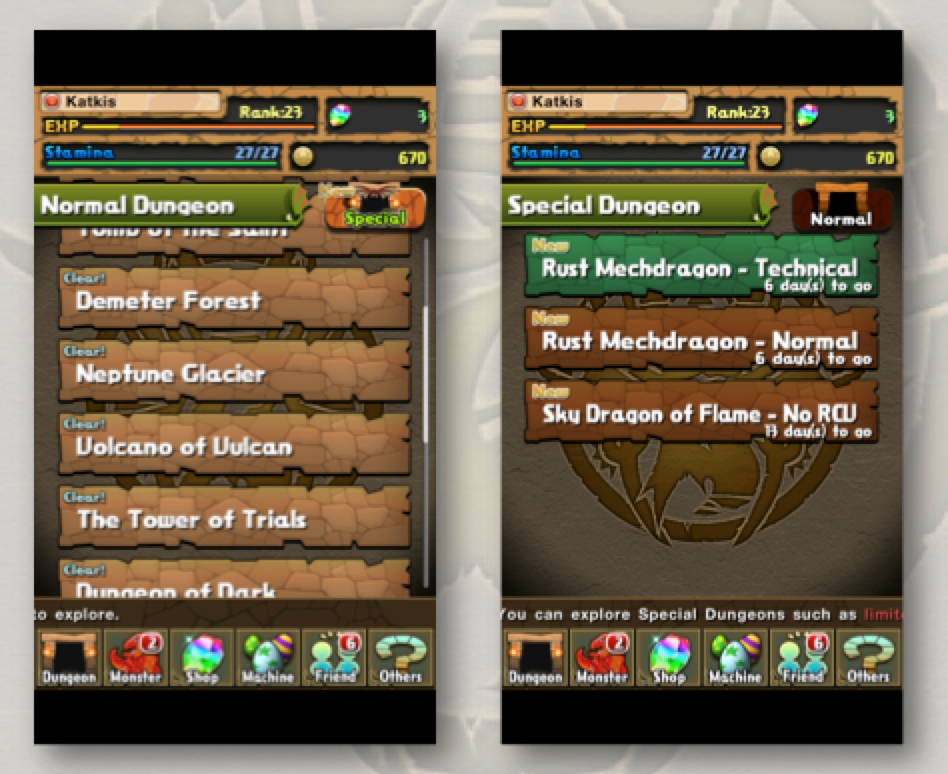
For trading and resource based games, having customers that have random requirements and give random rewards cycling throughout the day is an easy way to add excitement.
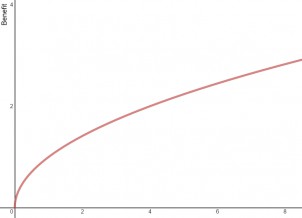
What would happen if these customers were all time-based?
Hay Day most likely didn’t add this because it makes setting long term goals very difficult for players. Players can’t predict if making bread for the next hour or milk is the right choice. So of course this has to be balanced with ensuring the player always has a clear deal they are going for, but can find interesting deals along the way to speed up their progress.
Your goal as a designer at the end of the day is to get players to come back for multiple sessions per day. Allow players to feel smart about taking advantage of one-time offer deals that progress them faster. This will make your game feel much more alive — it’s constantly changing, and a player can’t predict what the optimal path to completing the game will be. Progression will not be linear and boring. How often you need to grind, how many rounds you need to complete before you can beat the next boss isn’t laid out in front of you.
Most importantly — you will always have a reason to come back to the game.
Mobile Session Design: Player Commitment
Why does a player want to come back to your game?
As a mobile game designer, you need to come up with a very compelling answer. Creating a polished, addictive game is half the battle. You need to find ways to nudge your players to come back to the game after they have left. Designing your game around pulling your player back in is the critical battle on mobile.
So what games are good at pulling players back in? Not necessarily the games with the best mechanics.
Looking at the top ranks on the AppStore, it is inevitable as a traditional game designer that you will look at some of these games and be baffled at how they could possibly be so addicting and have so much traction. The player enters the game and collects simple rewards (which require no strategic input from the player). These actions levels up the player using archaic RPG mechanics, then the player quickly leaves. While it is easy to point and spot flaws, it is also important to recognize why these mechanics work on mobile. Specifically, these games allow the player to enter and exit the game very quickly. The player comes in, knows exactly what they need to do, quickly makes their strategic moves, and then leave to carry on with their daily lives. The game is adaptive to the player’s life, it allows them to complete a clear bite-sized section of gameplay within 30 seconds, and is clearly built with mobile in mind.
Yet despite how little time they are actually in the game, they are immersed in this environment while they are not even playing. While outside of the game, players commonly think of what they are going to do next, they plan out their long term goals, and rethink their strategy of their previous sessions. Even when the progression is fairly linear (for example, Cookie Clicker). This is an incredibly powerful technique that is a driving force of why these mobile games are so addicting. This is partially why FarmVille got its edge when it did, and why mobile games with similar mechanics continue to gain traction on Mobile platforms. So as a game designer, before you look to point flaws and discredit games that use these mechanics, challenge yourself to create a deep, immersive game mechanic which allows the player to obsess while they are away.
There are 3 strategies that help drive re-engagement on mobile :
- Building player commitments
- Always have reasons to return
- Flexible session design
Today I am only going to write about one: Player Commitments. The remaining two will follow in future blog posts.
Building Player Commitments
The most basic and impactful way to drive players to return after they have left your game is to push players to make a commitment to return before they leave the app.
The most well understood example of this is the farming crop mechanic. A player “plants” an object in your game, and chooses which contract they want: do they come back in 5 minutes for a little bit of crop, or in 4 hours for a large harvest. Regardless of which length they choose, they’ve made a commitment to return to the game.
Many social game designers have different takes on this method. It has been overused by farming style games, but it should not be underestimated for its value. If you manage to make the player care about coming back, this will drive re-engagement.
It is important to understand the difference between Opt-In commitments and opt-out commitments. A player should be able to select and commit to a selection of times to come back. They should not be forced into a specific time. There is distinct reasoning in allowing players to schedule their game around their life. If you take that control away from the player, then the mechanic fails to be a commitment, it just becomes an annoyance.
Adding Timers
If you use time-based commitments (or timers in general) it is important that you set the expectations correctly from the beginning. Timers should be only included in actions that are innately expected by the user. Repair times, travel times, investigation times are good examples of this. In reality, these actions take time, so of course the game will add a timer this.

Hay Day builds on the commitment systems of most farming games. Hay Day uses timers to pace the resource management and build interesting decisions. Timers are expected here — players understand that food takes time to produce, and the more complex the crafting is, the longer the time it takes.
Also ensure that timers are consistent — if starting an action sometimes has a timer and sometimes does not, this can really set users off.
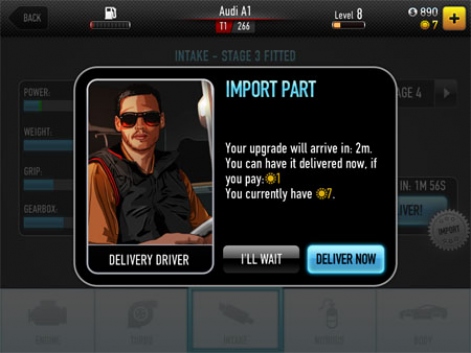
It was a bit odd that CSR had Import parts and non-import parts. In my opinion this mechanic would have been stronger if it was always imported, or the installation was always a set amount of time. Instead of players feeling like upgrades were randomly assigned import or non-import.
Lastly timers should not be added for every action of the game — namely it should only be added to areas that build excitement and anticipation. Adding timers to the end of an action loop is best. For example a player collects resources and then triggers building a structure. Or in Dragonvale when a player ends their loop with breeding two dragons :
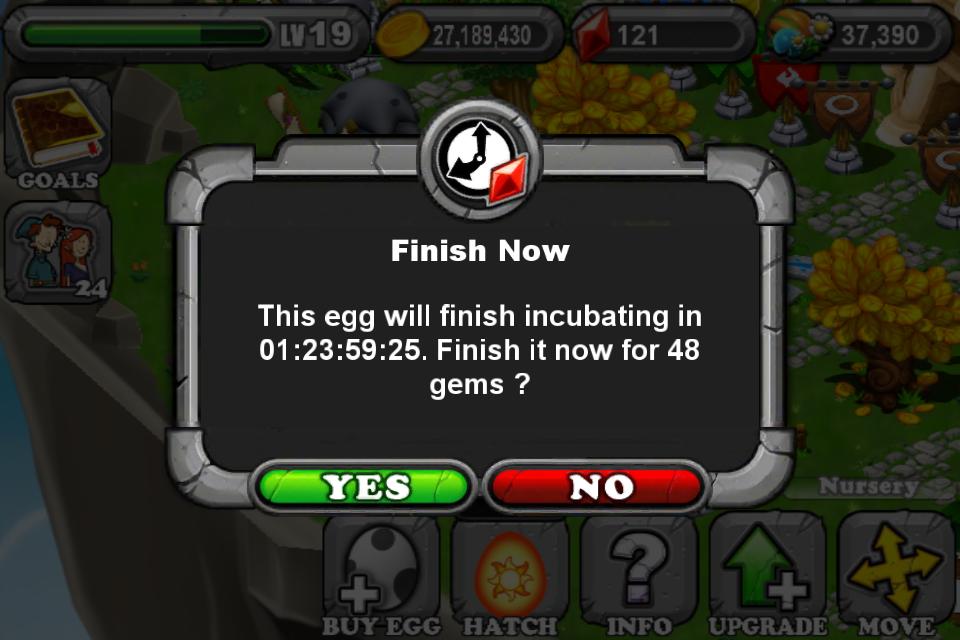
Dragonvale’s egg timer is adjusted based on the quality of the dragon that will come out. This builds anticipation.
Dragonvale does this superbly with the breeding timer. Engaged players know that long timers are exciting! The longer the timer, the better the dragon. This makes the timers feel great, and is added in an area that boosts the anticipation — finding out what’s in the egg.
Social Commitments
Timers are not the only way to pull players back. The current market is becoming more and more apprehensive about this type of mechanic. Instead of using time-based commitments, Social commitment is another angle that many games use.
Building a mechanic that revolves around active players collaborating, competing and communicating with each other can drive re-engagement.
Asynchronous Multiplayer
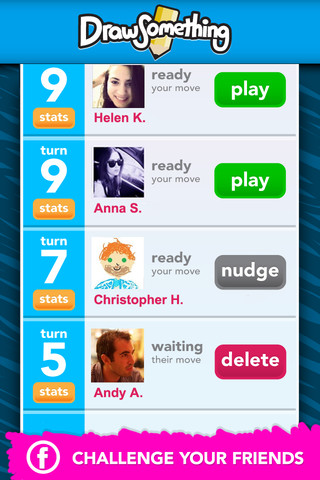
Asynchronous multiplayer is best found in games like Words with Friends, Draw Something and Tap Sports Baseball. They are games that revolve around social interactions between players. Each player makes a move in the game, then waits on their friend to make the next move. This has huge benefits for retention and virality. Players are prodding their friends in real life and through mobile push notifications to continue playing. Each time the player returns they have a set of games, ready to play.

The new words with friends adds a bit of “Tinder” to the app. Players are encouraged to play with random players to build social commitments.
The downside is that you physically can not play this mode unless you have friends that also own the game. This is the reason why these games are predominantly free, and also why they commonly take a long time to take off. The game only gets popular when a lot of players are playing it around the same time. Tap Sports and the New Words with friends have added new ways to start interacting with random strangers in the game. Not as engaging as playing with your real-life friends, but still better than playing with no one.
Challenges and Gifts
Depending on the nature of your game, a similar social connection to asynchronous multiplayer is the idea of challenges or gifts.
Gifts, like being able to send rewards to other players, is an easy way for players to push each other to play. This is not nearly as powerful as asynchronous multiplayer, but it does show some “social proof” that others are playing the game. The major benefit on mobile is that it can send a message to the other player. Popping up on their screen to rejoin the game.
Challenges can also be implemented as a “competitive gift”. Essentially players challenge another player to beat their score. This is a great way to push high score mechanics to be a bit more social. Players compete in one-time challenges and aim to defeat their friends as often as they can. A great idea is to incentivize this. Blend a bit more of a “gift” into the idea. So actually push players to challenge each other, and receive a reward regardless of winning or losing. This way players will push each other to play for quicker access to the rewards.
Social Leaderboards
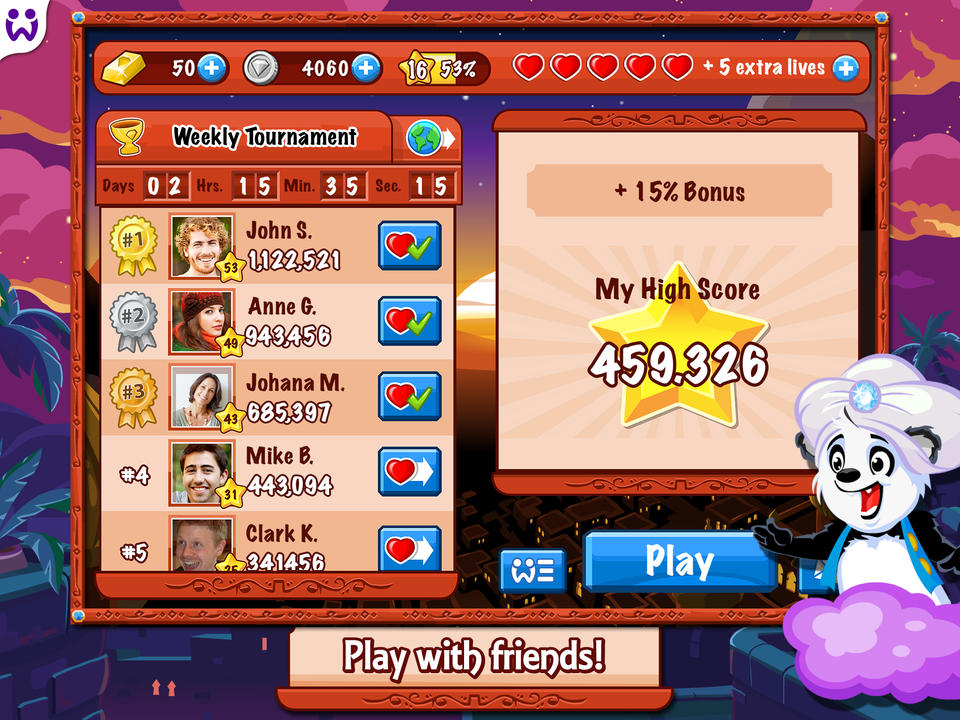
Wooga’s Diamond Dash is an example of what you can do with simple social game design. A social leaderboard engages players and creates commitments. Players want to beat their friends!
Leaderboards are not a new concept. It is basically a must-have with any standard game. Most players do not pay attention to them.
But that is only if you chose it not to be their focus.
Social Leaderboards can really be used as a mechanic to pull players back in.
If your game revolves around a central leaderboard, then you can use social notifications to make players very protective of their rank. When Player A beats Player B, make sure Player A can send B a nasty note, saying how terrible they are at the game. Make sure Player B can receive that note on their device, they will immediately come back into the game and play until they can push themselves back up the leaderboard. This can be a hugely compelling mechanic if built right. This focuses on more engaged users, and more casual audiences may be turned away if this is completely the focus.
One key issue happens when a leaderboard has no expiry. A player reaches an amazing score one week, but then never has to return to the game ever again since no one can beat them. It is far better to make your leaderboards expire, so that the winners have to return to claim their crow. A weekly “tournament” leaderboard is a great way for a player to be engaged on a real time basis.
Overall there are many more ways to build player commitments. Here I’ve spoken about two types that are common in games: Time based commitments and Social based commitments.
Regardless of how you design and what you choose, be sure to ask yourself during play testing:
Is there a compelling reason for our players to return to the game in the future?
Have players made a commitment to the game before leaving to encourage them to return?
In my next post I’ll discuss more “implicit” features that can drive re-engagement. It doesn’t always have to be about Timers or Social features. Looking at the most popular applications like Facebook and Twitter will give you a strong idea about how to drive players to want to return to your game multiple times per day.
Mobile Session Design: Easy In, Easy Out
Games that are designed specifically for mobile must always realize one thing :
Your users are distracted
This is sometimes counter productive to the true reason behind most game design. We want to create an immersive environment which the user enters this fantasy and is compelled to stay within the circle. This isn’t always possible with mobile games. Trying to force a user to stay within this circle and never break out is an uphill struggle.
The major restraint with working with mobile, is that it is in fact… mobile. They may not be sitting quietly in a chair, at home with minimal distractions playing your game. You can’t design your game around this ideal circumstance. You have to create that immersive environment so that it wraps neatly around the player’s day to day activities.
You have to design your game with distractions in mind.
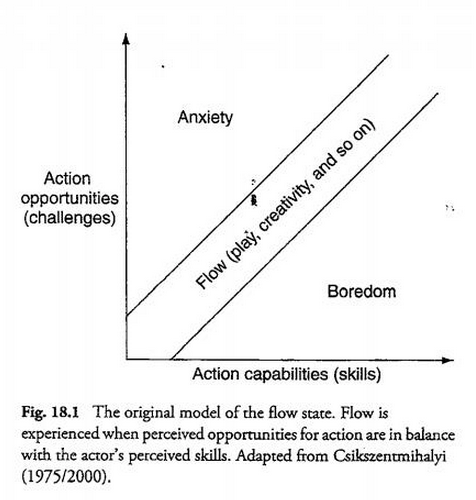
Mobile Game Design must account for a player with distractions. Specifically when they come back into a game. It’s all about managing a player’s flow state, and bringing them back into the “flow channel” (the balance between boredom and anxiety, building up their skills over time) as quickly as possible.
Immersion is still very possible in this mobile environment, but it takes on different forms. You have to design your game in such a way that at any time the user can leave, come back and still understand what it is they are supposed to be doing.
Dealing with distractions also means catering to your audience. You have to design game mechanics that adapt to the player’s life style. If your target audience is casual, then they have a smaller average session length then a core gamer. You have to design your game mechanics around getting your player in and out of the game within that average session length. They need to be able to get in, reach a high value part of the game quickly, then have the opportunity to leave without pain.
This is sometimes hard to incorporate in games that :
⦁ Depend on a strong narrative to lead the player
⦁ Require many complex steps which require the user to remember ongoing information
⦁ Push the player to play for long periods of time (5 minutes+ required to play)
Taking many cues from casual games, it is important that you design with intermittent play in mind.
Building a mechanic that allows the player to quickly enter the game. A game design that enables the player to quickly understand the game state as soon as possible.
Building a mechanic that allows the player to leave at any moment is imperative. You can’t assume the player will stay in your game for very long, life will usually take priority over playing a game for the player.
It’s important to not disrespect your players at this point. A great game will create a lot of depth and strategy while keeping within these constraints. Many games on the AppStore will dumb down their concept for mobile to a point that it lacks depth.
As always, it is important to understand and know who you’re targeting. If you’re targeting core gamers and want to introduce a lot of complex depth in the gameplay, then you can expect that your user base will be more likely to have higher play session lengths and minimize distractions. Games are higher priority for them (then life).
But even core gamers have distractions — and allowing them to play with depth while balancing these distractions will create an immersive game.
Easy In
Phone calls, texts, life will get in the way of your game — so make sure that your game can adapt to the player’s distractions. Easy In is about having an appropriate strategy for your player’s when they return from distractions. When the player returns to the game they should have as few clicks/steps as possible to return to the optimal game flow (the most exciting part of the game).
Turn-Based Games
The ideal design for a mobile game handling distractions is for the player to be able to exit the game whenever they want, and upon returning they are returned to the exact state they were in. Games that are turn-based can execute on this very easily. In a typical turn-based board game each turn has infinite time. So in the event the player leaves because of a distraction in the middle of game, has unlimited time to get ramped back into the game. The game would return right to game board, where the game’s optimal flow takes place. The player is quickly shown the game’s current state (the entire game board) and can easily think through their move. This is the ideal, since the gameplay is simple enough that the game state can be shown within one screen (the board) and the player has unlimited time to make the choice. Casual Games like Bejeweled do this well : even with a more arcade mechanic, each move the player makes has unlimited time for them to do so. This allows the player to put down their device, not worry about pausing the game, and return without worry. When returning, they can quickly understand the game state (all the jewel placement) and make a move at their leisure.
Angry Birds, Cut the Rope and Where’s my Water all have unlimited turn times for a very good reason. The player can return to the game from distractions and reach optimal game flow as quickly as possible.
Sometimes a player will need a little nudge. You want them to return to the optimal game flow as quickly and delicately as possible. So if the player just can’t spot the next move quick enough, it may be a good idea to “nudge” them to the right answer, so they can get back into the game quickly as possible. Bejeweled does this nicely. When a player hasn’t responded to the game in a few seconds, they add a nudge to show the player where a move is. Sometimes this can be disrespectful and insulting to the player, so use with caution. As always, understand your audience and decide how best to nudge without insulting their problem solving skills.
This ideal situation does not work for all games however. If your mechanic requires the player to make very quick responding moves or make a move within a specific amount of time, then a player coming back in the middle of a game move will cause panic. This isn’t the optimal game flow state. The casual player will panic.
Reaction Games
In arcade games, creating unlimited timed moves would absolutely kill the nature of the game. Timing, speed and panic are the core components of these games. So how do we ramp the player up quickly?
Well a naive solution is to cancel the previous game session they were having. When a player returns from a distraction, they must start from the beginning of the level. This is possible if your game sessions are 20 seconds or less. While the player will feel frustrated their 20 seconds of effort was wasted, this is a minimal punishment… but is still punishment.
The other solution is a pause menu. The player is able to pause the game at any point in the chaotic gameplay. This isn’t new. There was a reason why home console games had the “start” button in all games do this. I’m sure most parents would never had bought consoles for their kids if the pause button wasn’t invented. Many dinners would be skipped without pause menus.
It’s important to use the pause menu for a real purpose.
Cows vs Aliens used the pause menu to display briefly the game state (the player’s points, wave) and give them opportunity to trigger powerups. This doesn’t help the player return to the optimal game flow at all.
Here is how a casual player would return to Cows vs Aliens :
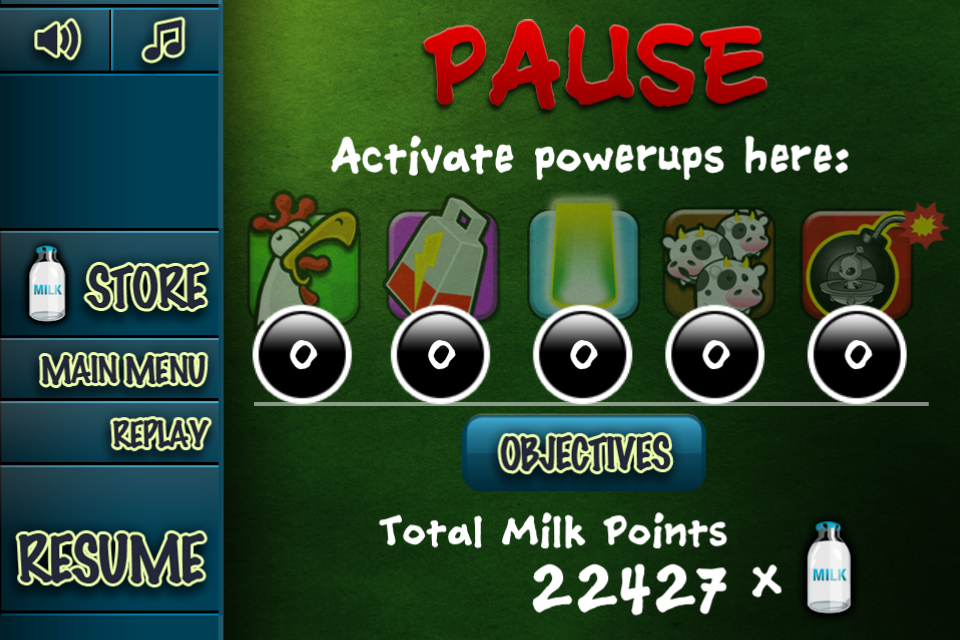
How a player would enter Cows vs Aliens upon returning to the game (locked screen, re enter the app)
⦁ Navigate the menu and try to find the resume button
⦁ Press the resume button
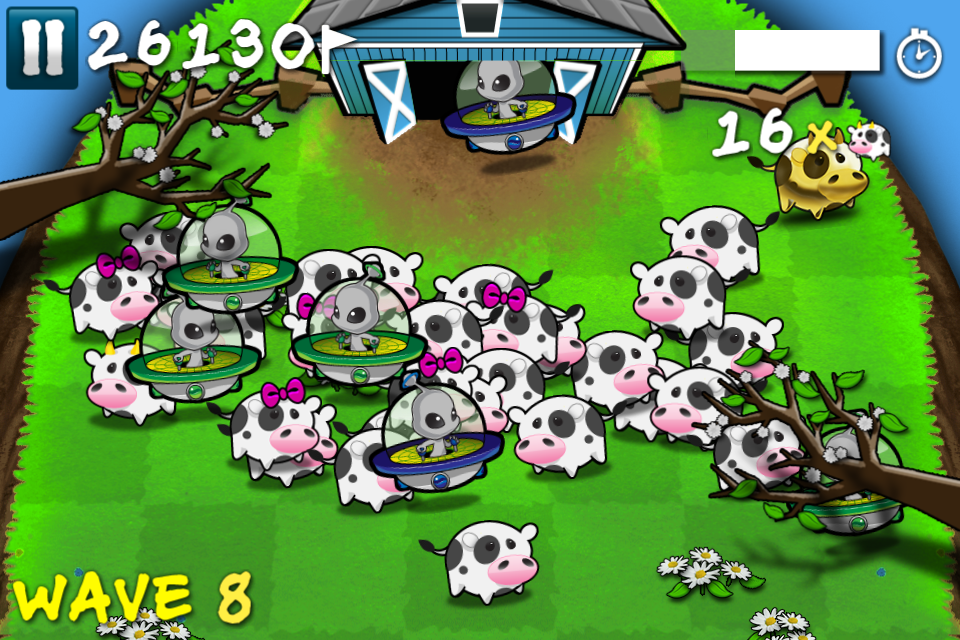
Instant Panic as the player returns to the game
⦁ Instant panic as the game snaps back to the game, there are aliens headed towards the barn.
⦁ As a casual player, they don’t respond in time, they don’t have enough time to get back into the game flow.
⦁ Game over screen.
⦁ Navigate the main menu to restart the game.
This is just an example, but in this case it would have been better for this player to just restart the whole game and start from the beginning again. The player wasn’t able to ramp up quickly enough, and because of that it took 6+ steps to get back into the optimal game flow, with a few steps making them feel inadequate of playing the game. Some players would drop out by this point.
Instead, allowing the player some ramp up time would be more ideal.
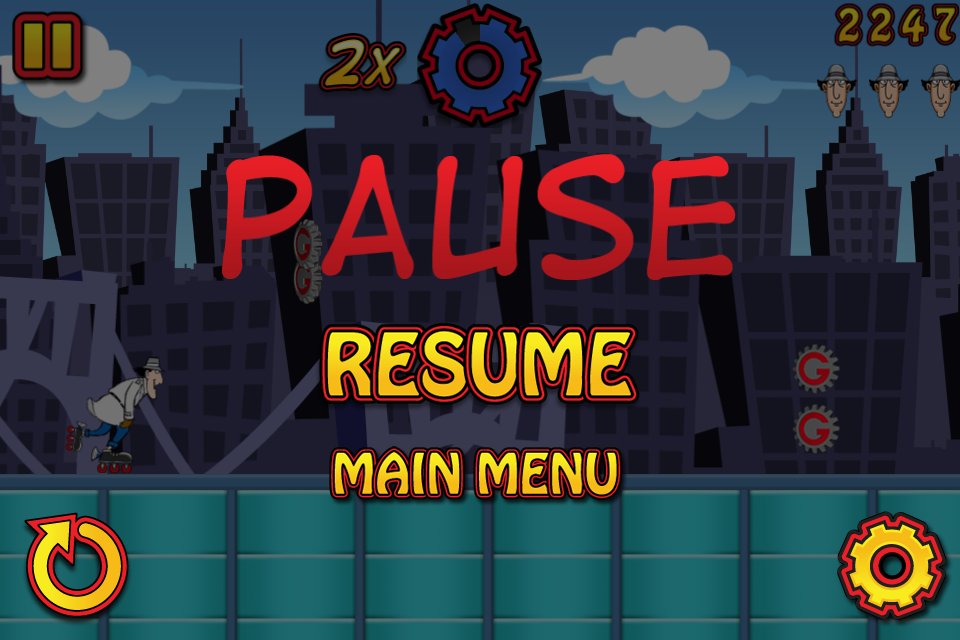
The Pause Screen is transparent
Notice in Inspector Gadget’s Mad Dash, the pause menu is transparent overlaying the actual gameplay. This is essential. Immediately when the player returns to the game, they can see the game state, can take their time, take a deep breath, then plunge back into the game flow. Just this basic design decision makes a massive difference in how players can come back into the game. In the event that the game is much further down the track, the player has a difficult jump to make, or returning to the game would cause a game over, the player can predict this when returning, and at least make the decision whether to give up and try again, or try it out. At least they are aware of their fault, and will try to fix it next time they get a distraction.
Taking this a step further, it’s important to nudge the player into the mechanic on a return as soon as possible. For more casual audiences, it may be more important to change the mechanic when the player returns from distraction to ease the player back into the mechanic. In an arcade situation, slow down the generation of obstacles, slow down the gameplay, and gradually speed the game back to its original state. Of course, close attention to exploits is important. You don’t want your player to use the pause menu to make the game easier.
Management Games
Management games, which involve the player managing their time, their town, their bakery shop, their pet shop, have challenges with managing easing a player back into the game play.
In a game like FarmVille, it can be overwhelming for a player when they come back into a game to understand what they should be doing. They have to water their crops, plant new ones, gift their friends, add more friends, purchase that new item, there’s that sale on that barn… do I need it? etc. etc. etc.
It can be a bit overwhelming. Especially as you add more steps and concurrent tasks to the player. Hyper-engaged players will not have a problem navigating this ocean of tasks, but many casual players, which you want to slowly ramp up to being more engaged can walk away when they are presented with so much choice.
In this case it’s important to think of how a returning user can be quickly ramped up in the game. The optimal player flow is for them to work through a step by step process, doing each of their required actions, then leaving the game. But that’s not fun. That’s too restrictive and requires no thought by the player. However, you can help the player organize their required tasks in a convenient list, and allow them to opt-in to following the list of steps in whatever order they choose.
When the player returns to the game, allowing them to press a button, or automatically bringing up their task list is a good idea. Each task should be a bite sized chunk of gameplay (collect all your plants, build a building, etc.). You can include some long term goals which require multiple sessions, but its important to hide these or allow the player to see them only when they’ve completed their short-term bite-sized goals first. Making these bite-sized and manageable within a few seconds allows the player to be nudged back into the core gameplay as soon as possible. It gives them a sense of accomplishment, and pushes them forward. Prioritizing quick wins over long-term victories is a great way to motivate people and to create habits.
Full Reset
Some games will restart the entire game from scratch every time the player opens the game. This is a terrible idea. While this will simplify the game start-up : the player will immediately understand what they need to do to continue (press play, start game from scratch) it clearly means that the game isn’t built with distractions in mind. If the player has to back-track and repeat more then a few steps of work to get them back to the game step they were at then this is just frustrating.
If your game can’t adapt to a player’s life then a player won’t adapt their life to play your game.
The only time which “restart completely” makes sense is when the player’s necessary steps to reach optimal flow is less if they just restarted from the beginning.
Easy Out
Easy out is all about making sure the player feels no remorse for leaving the game.
A big part to make sure this happens is having a good strategy for their return. Allowing the player to leave whenever they only works if the player knows that when they return it will be easy to get back into the game.
It’s also important to find ways to add hooks to the game so that the player has clear areas of the gameplay that they can leave without feeling like they are going to be punished on their return. Classic arcade games and the original console games were terrible at this. If you ever had to shut down your console, leave the arcade machine, you knew that your game state would be lost forever. The day your parents accidently unplugged your Nintendo console while you were in world 8 of mario surely caused scarring effects on your psyche. The day that you wrote down your MegaMan password wrong, and ended up back at the beginning made you throw the controller through the wall.
With mobile, we’ve evolved. We have far better solutions to this. Make sure your game does this as well. Easy Out is making sure that the player feels no remorse leaving the game flow. They can leave the game flow as often and as quickly as they need to.
No Penalty for Leaving
The biggest rule of easy out, is making sure there is no penalty for leaving.
This includes making sure that when they come back their difficulty does not spike. This happens inadvertently many times. Pausing during an intense arcade game will put the player back in the middle of the fray, this time without time to react to the game. This spikes the difficulty and punishes the player for leaving. Makke sure the game has an effective easy in strategy to manage this punishment.
Some games will pull the player back in the game allowing them to ramp up in the game easier. This is great to ramp up the player but has to be balanced with feeling like a punishment for leaving.
Have Coffee Breaks
The other important idea for easy out is to make sure you have plenty of “coffee breaks”. Every so often, the player should be able to take a break from the intensity and feel “OK” with leaving. Counter-intuitive when you want to create an immersive environment, but it depends on how you portray it to the user. You want to try to influence the player so that they leave at good areas of your game. This allows you to better design their return. In an arcade platformer game, It’s better for a player to stop playing your game between levels, than during. If a player exits your game during a level, they are far more likely to return to the game at a point that will confuse them. Having “safe zones” as often as possible allows the player to return to a point in which you as a designer can ramp them up as smoothly as possible. If a player feels like the next coffee break is too distant in the future, they are more likely to exit the game in an awkward area, then when you intend them to.
Do’s and Don’ts for Easy In, Easy Out
DO
⦁ Remind the user what it is they are supposed to do when they return
⦁ Have access to reference for information they are required to remember from previous sessions.
⦁ Have a clear “task list” which pushes the user to complete as many small chunks of gameplay they can
⦁ Have constant small chunks of gameplay actions with breaks which allow the player to leave at opportune times
⦁ When returning to the game, pause the action and allow the player to ease back into the game
DO NOT
⦁ Require the player to remember things from previous sessions
⦁ Have a long intricate story the user is required to remember each time they play
⦁ Have many complex steps for each step in the gameplay
⦁ Penalise the player for leaving in any way
⦁ Require the player to play for over 1 minute continuously


























